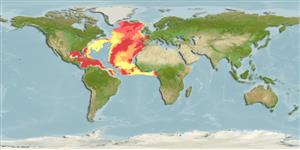>
Lophiiformes (Anglerfishes) >
Linophrynidae (Leftvents)
Etymology: Linophryne: Greek, 'linon' = flax or anything made of flax such as "cord," "rope," or a "net" + Greek, 'phryne' = "toad" (refers to a toadlike fish that fishes with a net) (Ref. 86949).
More on author: Beebe.
Environment: milieu / climate zone / depth range / distribution range
Ökologie
seewasser bathypelagisch; standorttreu; tiefenbereich 600 - 2000 m (Ref. 86949). Deep-water
North Atlantic: North of 30°N, from Bermuda to Madeira and north of the Azores.
Size / Gewicht / Alter
Maturity: Lm ? range ? - ? cm
Kurzbeschreibung
Morphologie | Morphometrie
Rückenflossenweichstrahlen (insgesamt): 3; Afterflossenweichstrahlen: 3. Females distinguished by the following characteristics: distal escal appendage less than 10% SL; short posterior ascal appendage present; barbel divided nearly at base into 3 unpaired primary branches; subdermal pigment in two bands on side of body; males without pointed sphenotic spines (Ref. 86949).
Parasitic males.
Life cycle and mating behavior
Geschlechtsreife | Fortpflanzung | Ablaichen | Eier | Fecundity | Larven
Bertelsen, E., 1986. Linophrynidae. p. 1408-1414. In P.J.P. Whitehead, M.-L. Bauchot, J.C. Hureau, J. Nielsen, and E. Tortonese (eds.) Fishes of the North-eastern Atlantic and the Mediterranean. UNESCO, Paris, Vol. 3. (Ref. 13578)
IUCN Rote Liste Status (Ref. 130435)
Bedrohung für Menschen
Harmless
Nutzung durch Menschen
Fischereien: nicht kommerziell
Mehr Information
NamenSynonymeMetabolismusRäuberÖkotoxikologieFortpflanzungGeschlechtsreifeAblaichenSpawning aggregationFecundityEierEientwicklung
Alter/GrößeWachstumLänge-GewichtLänge-LängeLängenhäufigkeitenMorphometrieMorphologieLarvenLarven Pop.Dyn.RekrutierungDichteBRUVS
ReferenzenAquakulturAquakultur ProfilZuchtlinienGenetikElectrophoresesVererbbarkeitKrankheitenVerarbeitungNutrientsMass conversion
PartnerBilderStamps, Coins Misc.LauteCiguateraGeschwindigkeitSchwimmstilKiemenoberflächeOtolithsGehirngrößeSehfähigkeit
Tools
Zusatzinformationen
Download XML
Internet Quellen
Estimates based on models
Preferred temperature (Ref.
123201): 3.2 - 3.7, mean 3.5 °C (based on 128 cells).
Phylogenetic diversity index (Ref.
82804): PD
50 = 0.5000 [Uniqueness, from 0.5 = low to 2.0 = high].
Bayesian length-weight: a=0.01995 (0.00906 - 0.04395), b=3.01 (2.83 - 3.19), in cm total length, based on all LWR estimates for this body shape (Ref.
93245).
Trophic level (Ref.
69278): 3.7 ±0.6 se; based on size and trophs of closest relatives
Fishing Vulnerability (Ref.
59153): Low vulnerability (10 of 100).
